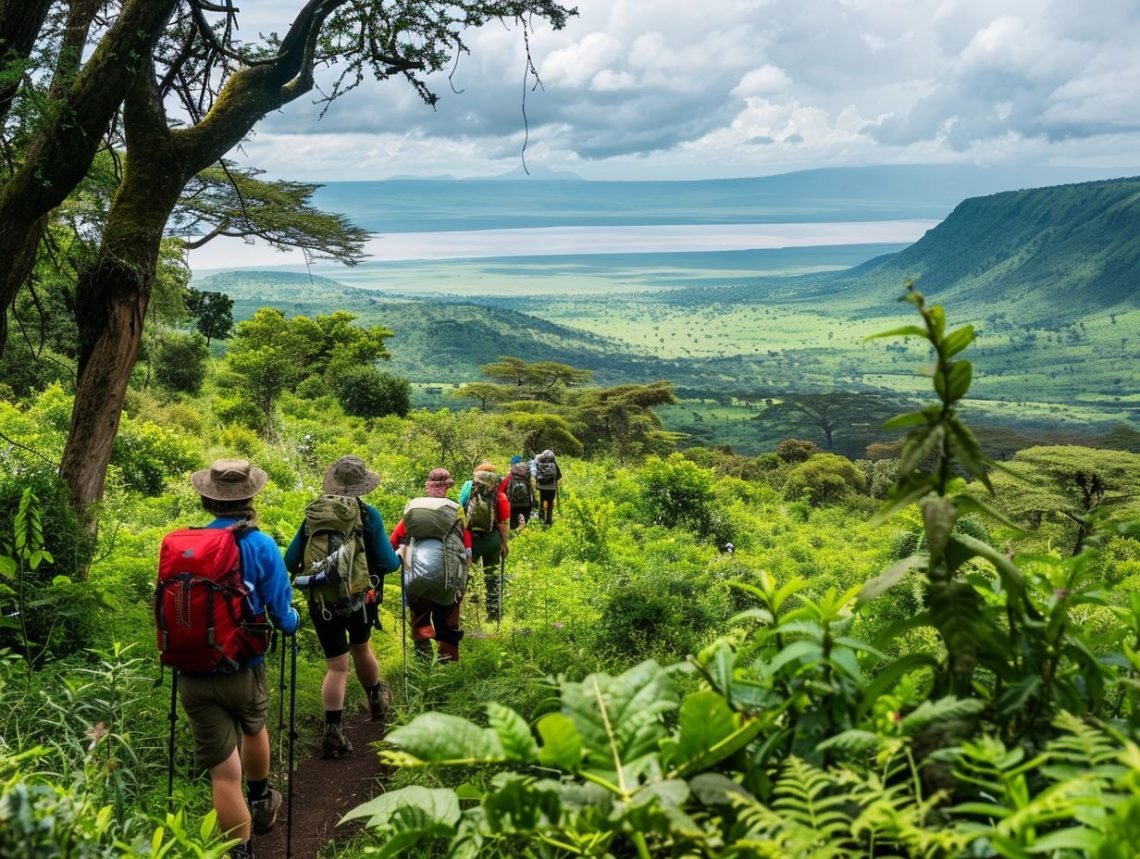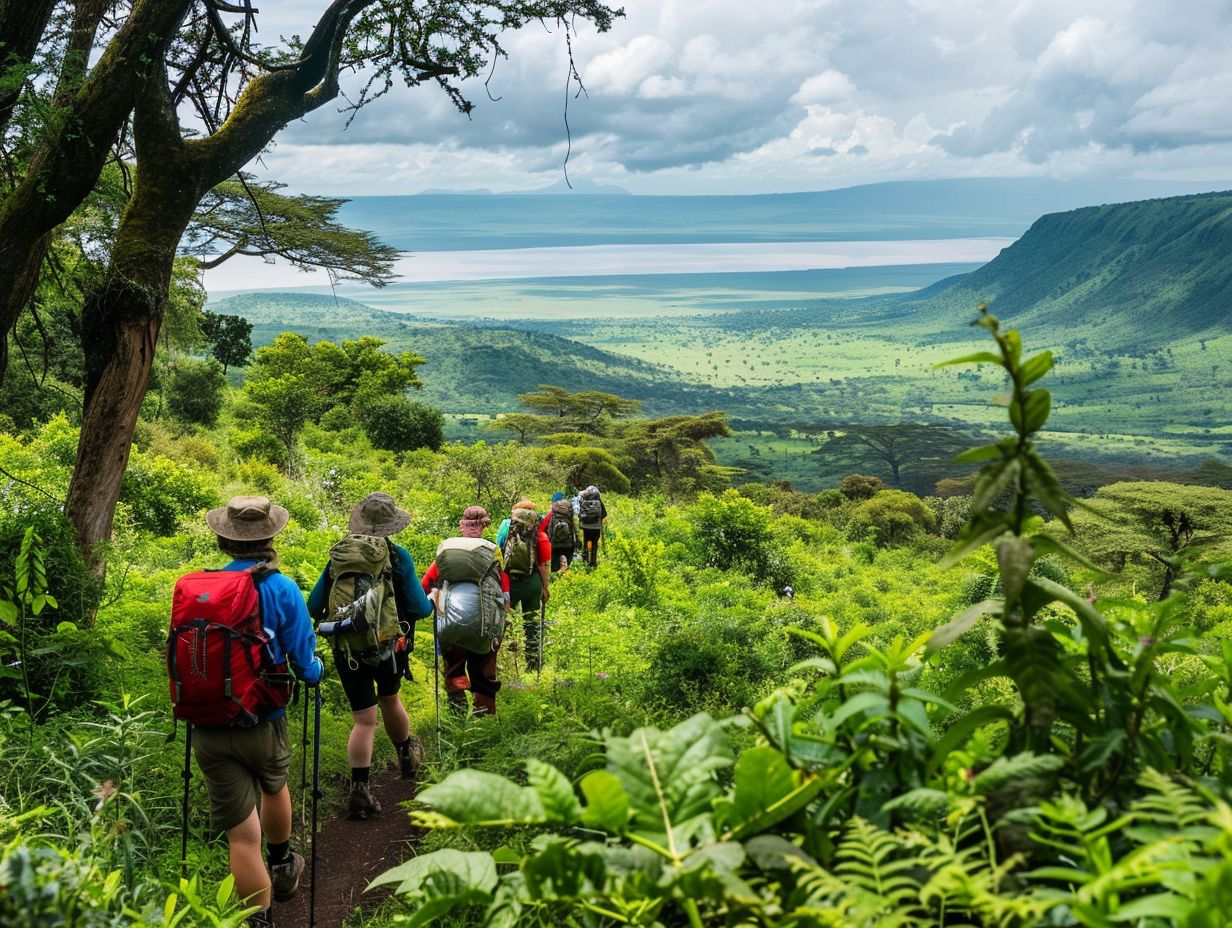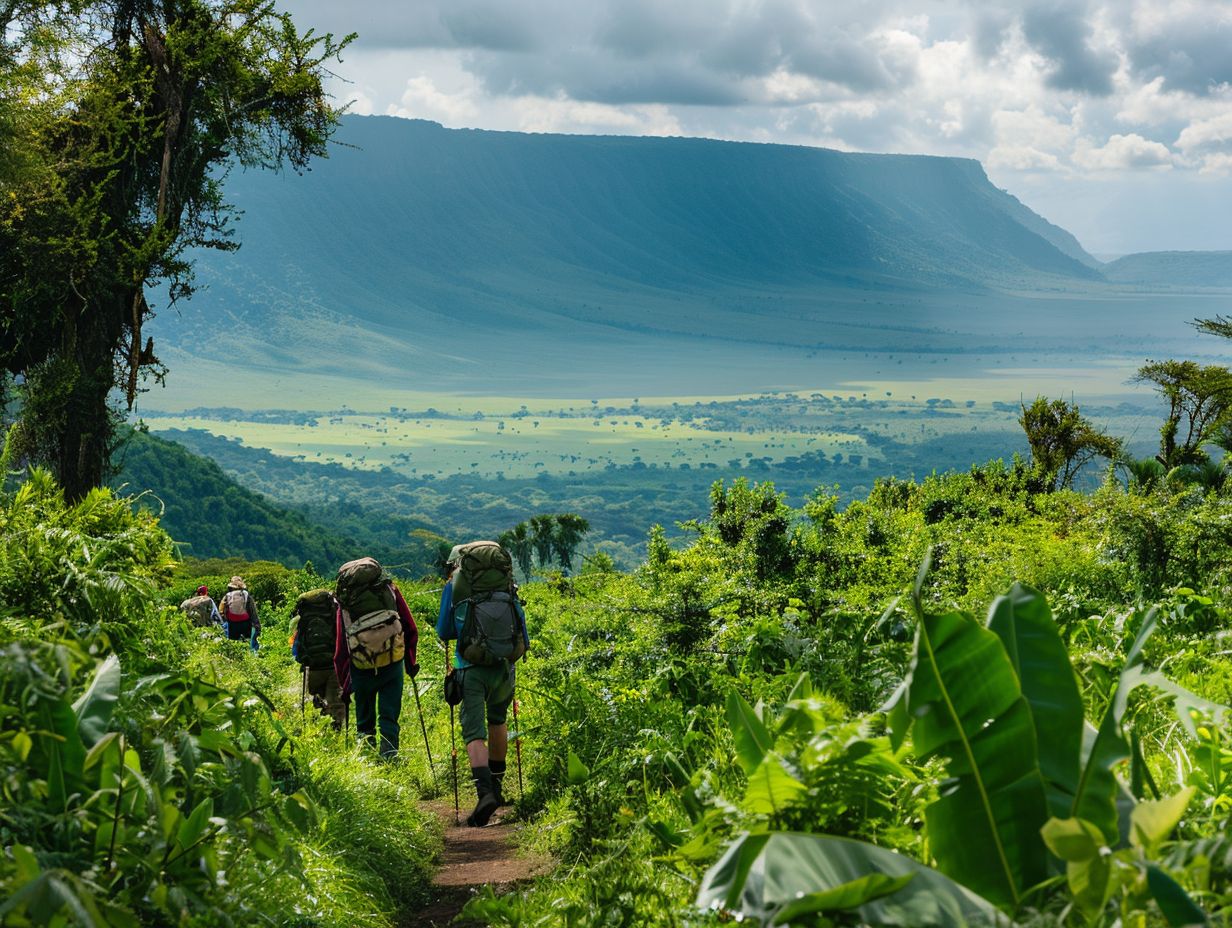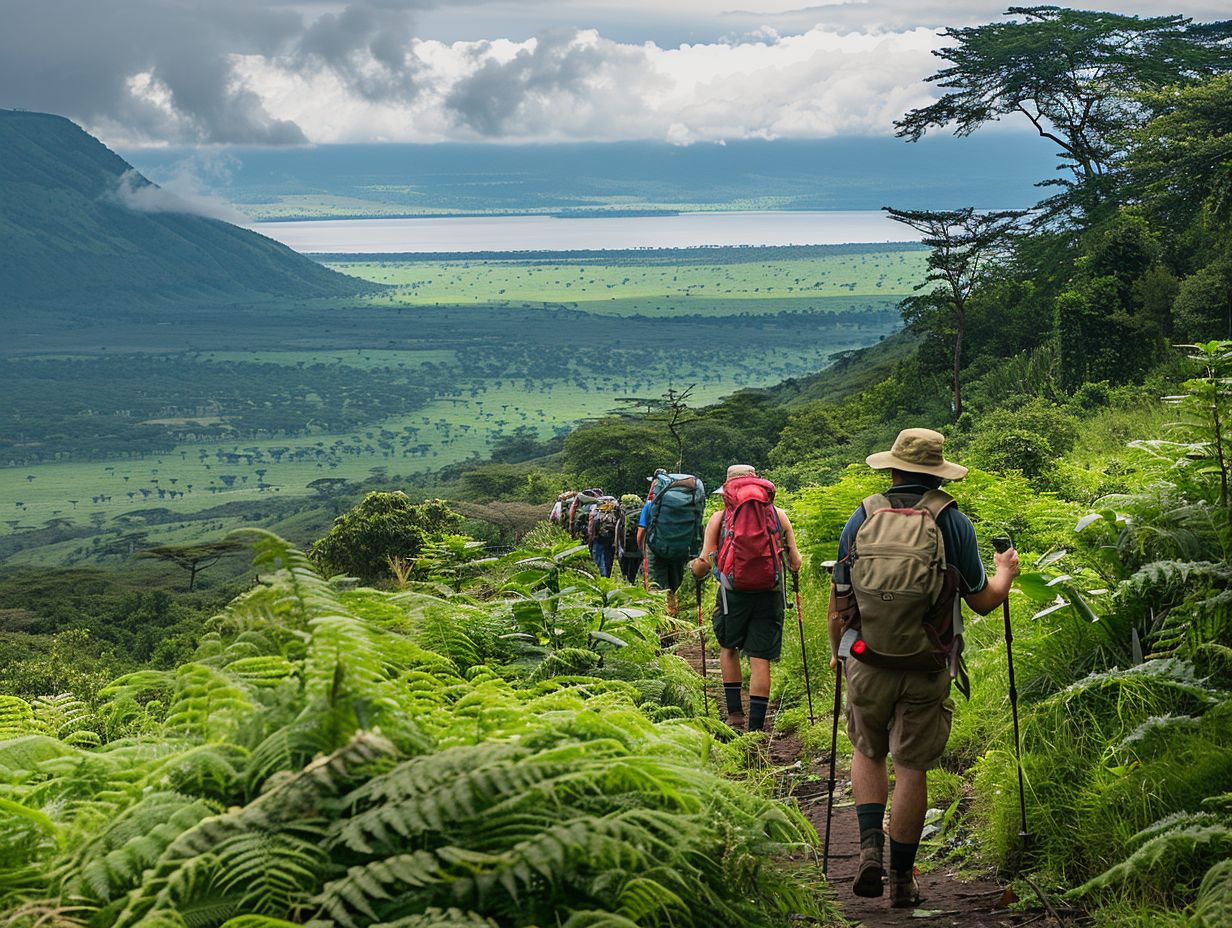
Ngorongoro Trekking
Have you ever dreamed of embarking on a thrilling trek through the stunning landscapes of Ngorongoro?
Explore everything you need to know about Ngorongoro trekking in this comprehensive article.
From its location and the best time to visit, to the physical requirements and safety precautions, we’ve got you covered.
Discover the highlights of Ngorongoro trekking, the different routes available, accommodation options, costs involved, and how to prepare for this unforgettable adventure.
Get ready to immerse yourself in the beauty of Ngorongoro like never before!
Key Takeaways:

- Ngorongoro Trekking offers an immersive experience in the stunning landscapes and rich wildlife of Tanzania.
- The best time to go on a Ngorongoro Trek is during the dry season from June to October.
- Safety precautions, physical requirements, and appropriate gear are essential for a successful Ngorongoro Trek.
Where Is Ngorongoro Located?
Ngorongoro is situated in Tanzania, within the Ngorongoro Conservation Area, known for its breathtaking Ngorongoro Crater, a haven for wildlife and natural beauty.
The Ngorongoro Conservation Area is located in the northern part of Tanzania, bordering the Serengeti National Park to the west.
Its proximity to these renowned destinations makes it a popular stop for safari enthusiasts exploring the region.
The area’s unique landscape, characterized by the crater’s steep walls and diverse ecosystem, attracts a wide range of wildlife, including lions, elephants, and rhinos.
This natural wonder is also a UNESCO World Heritage Site, showcasing the importance of conservation efforts in protecting such exceptional environments.
What Is the Best Time to Go on a Ngorongoro Trek?
The best time to embark on a Ngorongoro trek is during the dry season when wildlife sightings are abundant, and the weather conditions are ideal for hiking and exploration.
During the dry season in Ngorongoro, from June to September, the landscapes transform into a picturesque setting of lush greenery and clear skies.
Temperatures during this period are moderate, creating comfortable conditions for long hikes and wildlife observation.
The skies remain mostly clear, offering unobstructed views of the breathtaking scenery that unfolds in this unique ecosystem.
The dry season also coincides with the Great Migration, where thousands of wildebeests and zebras traverse the savannah in search of greener pastures.
What Are the Physical Requirements for Ngorongoro Trekking?
Ngorongoro trekking demands a moderate level of physical fitness due to varying terrains, altitude changes, and extended periods of walking while observing wildlife and exploring the wilderness.
Endurance is crucial for trekkers as they navigate through the rugged landscapes, from the crater rim down to the grassy plains, requiring stamina.
Maintaining a steady pace over long distances, sometimes in challenging weather conditions, necessitates a good level of cardiovascular fitness.
Trekkers must also possess stability and agility to traverse rocky paths and uneven ground, ensuring they are prepared for the physical demands of the journey ahead.
A balanced approach to physical training, incorporating strength, flexibility, and endurance exercises, can help adventurers tackle the various challenges.
What Are the Safety Precautions for Ngorongoro Trekking?
Ensuring safety during Ngorongoro trekking involves following guidelines from experienced guides, maintaining a safe distance from wildlife, and being prepared for unexpected situations in the wilderness.
When exploring the breathtaking landscapes of Ngorongoro, it’s crucial to respect the natural habitat and its inhabitants.
By keeping a respectful distance from wildlife, you not only ensure your safety but also contribute to the conservation of these magnificent creatures.
Wildlife awareness plays a vital role in preventing unnecessary interactions that could lead to dangerous situations.
Always listen to your guide’s instructions as they possess valuable knowledge about the area and its potential risks.
Packing essential emergency supplies and knowing how to use them can make a significant difference in handling unforeseen events.
What Are the Necessary Gear and Equipment for Ngorongoro Trekking?
The essential gear and equipment for Ngorongoro trekking include sturdy hiking boots, breathable clothing, a hat, sunscreen, binoculars, a camera, and a refillable water bottle for a comfortable and safe trekking experience.
Along with the basic gear, good quality backpack with padded straps to carry essentials and snacks is essential to ensure comfort during long treks.
It is recommended to have moisture-wicking socks to prevent blisters and discomfort from moisture. A lightweight and compact sleeping bag is necessary.
How Long Does a Ngorongoro Trek Usually Take?

A typical Ngorongoro trek usually spans several days to fully explore the diverse landscapes, observe wildlife, engage in cultural experiences, and savor the natural wonders.
During the Ngorongoro trek, travelers immerse themselves in the beauty of the Ngorongoro Conservation Area, spending nights under the starlit sky.
The multi-day itinerary often includes guided safaris to spot the renowned Big Five, such as lions, elephants, buffaloes, leopards, and rhinos.
The excursion requires ample time to appreciate the enchanting sunrise and sunset views, embark on nature walks, visit Maasai villages, and relish hearty bush meals.
What Are the Highlights of Ngorongoro Trekking?
The highlights of Ngorongoro trekking encompass the breathtaking Ngorongoro Crater, encounters with diverse wildlife, immersion in Maasai culture, and the exploration of unique ecosystems and habitats.
1. Ngorongoro Crater
The Ngorongoro Crater is a natural wonder teeming with diverse wildlife, offering unparalleled safari experiences amidst stunning landscapes and a unique conservation area.
Formed millions of years ago from a massive volcano eruption, the Ngorongoro Crater boasts a resemblance to the famed Garden of Eden .
This geological marvel spans over 100 square miles and is home to a vast array of wildlife, including the Big Five – lions, elephants, buffaloes, rhinos, and leopards.
Safari enthusiasts are in for a treat as this UNESCO World Heritage Site allows for up-close encounters with these majestic creatures within the crater’s confines.
The rich biodiversity and stunning panoramas make every safari expedition a memorable adventure, with the chance to witness predators , herbivores grazing, and a myriad of bird species soaring.
2. Olduvai Gorge
Olduvai Gorge is a renowned archaeological site in the Ngorongoro region, known for its rich fossil discoveries and contributions.
This historical site holds immense significance as it has provided archaeologists and paleoanthropologists with a window into the past.
- The excavations at Olduvai Gorge have unearthed a treasure trove of ancient remains, including tools, cultural artifacts, and most notably, the discovery of Homo habilis, one of the earliest known species of the Homo genus.
- These findings have revolutionized our understanding of human evolution, bridging gaps in our knowledge and painting a vivid picture of our ancestors’ lives.
- The stratigraphy of the gorge has played a pivotal role in reconstructing the timeline of human development.
- The layers of sediment at Olduvai Gorge function as a timeline, showcasing the progression of species and technological advancements over millions of years.
- The pioneering work of renowned paleoanthropologists such as Mary and Louis Leakey has solidified the status of Olduvai Gorge as a cornerstone in the field of anthropology.
Their discoveries have reshaped scientific paradigms and continue to inspire generations of researchers to delve deeper into the origins of humankind.
3. Maasai Culture
The Maasai culture is an integral part of Ngorongoro trekking, offering enriching cultural experiences through interactions with the Maasai community.
Visitors have the opportunity to witness traditional ceremonies such as the iconic jumping dance, and milking goats or crafting traditional beaded jewelry.
The Maasai’s deep connection to nature and their sustainable way of living provide valuable insights into harmonious coexistence with the environment and wildlife.
What Are the Different Routes for Ngorongoro Trekking?
Ngorongoro trekking offers various routes including the scenic Lemosho Route, the challenging Machame Route, the secluded Rongai Route, and the expansive Northern Circuit Route, each providing unique trekking experiences.
1. Lemosho Route
The Lemosho Route is renowned for it’s scenic beauty, diverse landscapes, and serene forests, making it a popular choice for trekkers.
The route traverses through a variety of terrain, from expansive moorlands to rocky ridges, offering a visual feast for nature enthusiasts.
Panoramic views greet you at every turn, showcasing the majestic peaks of Mount Kilimanjaro in all its glory.
Along the way, you encounter unique attractions such as the Shira Plateau and Barranco Wall, each adding a distinctive charm to the trek.
The forests along the Lemosho Route are teeming with life, from exotic bird species to elusive wildlife, creating a symphony of sights and sounds.
2. Machame Route

The Machame Route is renowned for its challenging terrain, steep climbs, and rewarding summit views, attracting experienced trekkers.
As trekkers navigate through the rugged terrain, they encounter a variety of landscapes, from dense rainforests to rocky ridges, offering an immersive experience.
The route’s difficulty level tests one’s physical endurance and mental resilience, with steep sections that require careful navigation and stamina.
The breathtaking views and the camaraderie among fellow trekkers create lasting memories, making every step worth the challenge.”
3. Rongai Route
The Rongai Route offers a secluded trekking experience through pristine wilderness, away from the crowds, providing trekkers with a sense of tranquility.
As you ascend through the enchanting forests and open moorlands of the Rongai Route, you’ll be surrounded by untouched beauty and serenity.
The route’s unique feature lies in its northern approach, granting trekkers a different perspective of Kilimanjaro.
The gradual slopes and fewer fellow hikers contribute to a peaceful trekking ambiance, allowing you to absorb the wilderness at your own pace.
With its less traveled paths, the Rongai Route offers a more personal connection to the mountain and its surroundings, truly making it a hidden gem.
4. Northern Circuit Route
The Northern Circuit Route offers an expansive trekking journey through diverse landscapes, from lush forests to alpine deserts.
As trekkers navigate through the Northern Circuit Route, they are greeted with a captivating blend of ecosystems, each brimming with unique flora and fauna.
The trail meanders through vibrant rainforests teeming with life, ascending to rocky terrains that showcase the rugged beauty of the alpine zone.
Challenging ascents give way to sweeping vistas of snow-capped peaks, underscoring the unparalleled beauty of the region.
Along the way, trekkers may encounter diverse wildlife, from colobus monkeys swinging through the trees to elusive mountain elephants silently traversing the rocky slopes.
What Are the Accommodation Options for Ngorongoro Trekking?
Accommodation options for Ngorongoro trekking include camping under the stars in designated campsites or staying in comfortable lodges and camps that offer a range of facilities and amenities for trekkers.
1. Camping
Camping during a Ngorongoro trek offers an authentic outdoor experience, allowing trekkers to immerse themselves in nature and sleep under the stars.
Waking up to the crisp morning air, surrounded by majestic landscapes, creates a feeling of peace and tranquility that is hard to replicate elsewhere.
The tent facilities in these campsites are designed to blend in with the natural surroundings, offering basic amenities while still allowing guests to feel close to the earth.
Whether you’re a seasoned camper or trying it for the first time, there’s something magical about spending a night in a tent in the heart of the African wilderness.
The experience of cooking over a campfire, listening to the nocturnal symphony of wildlife, and gazing at the star-filled sky is an unforgettable adventure.
2. Lodges
Staying in lodges during a Ngorongoro trek offers comfort, convenience, and additional amenities for trekkers, providing a relaxing retreat after a day of exploring.
These lodges boast well-appointed rooms with cozy beds and modern bathrooms, ensuring a good night’s sleep in the heart of nature.
Along with comfortable accommodations, visitors can unwind in spacious lounges or outdoor terraces, savoring delicious meals prepared by talented chefs.
Compared to camping, where trekkers are confined to tents, lodge stays elevate the experience by offering a touch of luxury and comfort.
What Are the Costs Involved in Ngorongoro Trekking?
The costs of Ngorongoro trekking vary depending on the chosen route, accommodation type, guide services, and additional activities.
Several factors influence the pricing structure of Ngorongoro trekking, such as the duration of the trek, the level of accommodation comfort, the expertise of the guide, and the inclusion of special excursions.
Rates can range from budget-friendly options for backpackers seeking basic facilities to luxurious packages that offer exclusive lodges with premium amenities.
Comparing the value offered by different packages is essential, as some may include additional services like airport transfers, photography sessions, or educational talks by local conservationists.
How to Prepare for a Ngorongoro Trek?

Preparing for a Ngorongoro trek involves researching the route, securing necessary permits, packing appropriate gear, booking accommodations, and familiarizing oneself with the wildlife, climate, and cultural experiences.
Researching the route is crucial to understand the terrain, ecosystems, and potential challenges along the way.
It’s essential to check the latest regulations and permit requirements from the Ngorongoro Conservation Area Authority.
Regarding packing, proper gear such as sturdy hiking boots, lightweight clothing, a good backpack, water bottles, sunscreen, and insect repellent is vital.
Also, booking accommodations in advance ensures a comfortable stay after a long day of trekking.
Learning about the local wildlife, weather patterns, and cultural norms enriches the experience, fostering greater appreciation for the environment and the people.
Frequently Asked Questions
1. What is Ngorongoro Trekking?
A: Ngorongoro Trekking refers to the activity of hiking and exploring the Ngorongoro Conservation Area in Tanzania, which is home to the famous Ngorongoro Crater. It is a popular tourist destination for its unique landscape and diverse wildlife.
2. What are the main attractions of Ngorongoro Trekking?
A: The main attraction of Ngorongoro Trekking is the Ngorongoro Crater, which is the world’s largest inactive and intact volcanic caldera. It is also home to a wide variety of animals, including the “Big Five” (lion, leopard, elephant, buffalo, and rhino) as well as numerous bird species.
3. How long does it take to complete Ngorongoro Trekking?
A: The duration of Ngorongoro Trekking depends on the specific route and pace chosen by the hikers. On average, it can take 3-5 days to complete the trek, including overnight camping at designated campsites along the way.
4. What is the best time of year for Ngorongoro Trekking?
A: The best time of year for Ngorongoro Trekking is during the dry season, which runs from June to September. This is when the weather is cooler, there is less chance of rain, and the wildlife congregates around water sources, making it easier to spot them.
5. Is Ngorongoro Trekking suitable for all fitness levels?
A: Ngorongoro Trekking can be physically demanding, especially when trekking up steep terrain. It is recommended for individuals who are in good physical condition and have some hiking experience. However, there are also less strenuous routes available for those with lower fitness levels.
6. Are there any safety precautions to consider when Ngorongoro Trekking?
A: While Ngorongoro Trekking is generally a safe activity, there are some precautions to keep in mind. It is important to always follow the instructions of your guide, stay on designated trails, and avoid getting too close to wild animals. It is also recommended to bring appropriate gear, such as sturdy hiking boots and sunscreen.